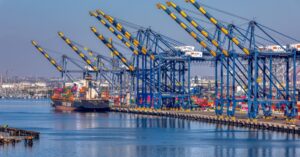As supply chain challenges continue to rise, more shippers are diversifying their supplier base, especially for drayage and ocean freight operations, to foster greater reliability and resilience.
We look at that diversification as well as other industry trends and news in this edition of the COGISTICS Transportation newsletter. Continue reading to learn more.
ILA Dockworkers Clinch Major Wins With New Labor Deal
Unionized dockworkers have secured a groundbreaking six-year labor agreement that includes a 62% pay increase and significant limitations on automation at East and Gulf Coast ports. This comes after a long tug-of-war between the International Longshoremen’s Association (ILA) and United States Maritime Alliance (USMX), with a tentative deal reached just a week before a potential strike deadline.
The agreement introduces stricter guidelines for implementing new technologies, requiring companies to hire additional dockworkers for every semiautomated crane added. While companies sought to improve productivity through automation, the ILA successfully maintained a ban on full automation and limited the use of artificial intelligence if it replaced workers.
The new terms provide a clearer process for introducing technology without reducing staffing levels, balancing industry innovation with job preservation. The deal, which still requires ratification by ILA members, is expected to increase operational costs for employers, adding pressure to an industry already grappling with global disruptions and rising expenses.
Shippers Turn to Diversified Drayage Strategies to Manage Supply Chain Challenges
Shippers are increasingly opting to spread their cargo volumes across multiple drayage carriers to mitigate the risks associated with supply chain disruptions. Traditionally reliant on single carriers, many importers are now diversifying their logistics partnerships to enhance reliability. This shift reflects changes in attitudes and the adoption of technology that facilitates better management of carrier networks.
The drayage industry in the United States, characterized by its fragmentation with more than 12,000 carriers and 49,000 drivers, has faced pressures from fluctuating demand and thin profit margins. Through diversification, shippers are equipped to handle capacity challenges more effectively, particularly during periods of inconsistent volume or surges in demand. Industry leaders recommend maintaining relationships with several carriers to balance costs and capacity needs, especially for high-volume or specialized cargo types.
Trucking Leaders Anticipate Policy Shifts Under New Administration
With Donald Trump just about a week away from helming the government again, trucking leaders have shown optimism about his second term in office. American Trucking Associations (ATA) President Chris Spear and other industry leaders have expressed hope about positive policy changes under the president-elect. A key focus is the regulation of electric trucks, with concerns about California’s emissions timelines and infrastructure readiness mandates.
Spear highlighted the economic and logistical challenges of transitioning to electric vehicles, citing prohibitive costs and inadequate charging infrastructure. The trucking industry also hopes for federal action to address “nuclear verdicts” in lawsuits, proposing to shift such cases to federal courts. Meanwhile, industry representatives expect a pause on the onslaught of aggressive regulatory initiatives, including changes to greenhouse gas emission standards for heavy-duty vehicles.
Experts also believe that the Trump administration will move swiftly, leveraging lessons from his first term to address these and other trucking-related issues effectively.
Manufacturing Poised for Growth as 2024 Ends on an Upward Trend
The manufacturing sector closed out 2024 with a rise in demand and production, as shown by the Institute for Supply Management’s Purchasing Managers Index (PMI), which reached 49.3% in December. New orders climbed to 52.5%, and production hit 50.3%, signaling potential growth as the industry enters 2025. Seven manufacturing categories, including primary metals and electrical equipment, reported expansion in December.
Despite concerns about potential tariff hikes, which 40% of survey respondents mentioned, the sector’s immediate impact is expected to be limited until the second quarter of 2025. Meanwhile, S&P Global’s index reflected a slight dip in December, with optimism tied to expectations of reduced regulations and increased support for domestic manufacturing under the incoming administration.
Rising Penalties Highlight Urgency of Trade Compliance
Penalties for breaching the U.S. import and export regulations have increased significantly over the past six months, with further hikes scheduled to take effect after Jan. 15. Among the adjustments, fines for violating the 2018 Export Controls Act will rise from $364,992 to $374,474. These changes apply retroactively to violations occurring before the effective date.
Compliance experts have emphasized the growing need for vigilance. Hugo Pakula, a customs expert, warned of the rising costs of noncompliance, while other professionals highlighted the financial risks posed by evolving regulations. Over the past six months, penalties have become more frequent, reflecting increased enforcement.
Seamless Shipments With COGISTICS Transportation
We’re more than an average logistics provider in the market. At COGISTICS Transportation, we pride ourselves on being your end-to-end partner and driving success through collaborative logistics solutions.
With COGISTICS Transportation, complexity becomes clarity, and logistics becomes a competitive advantage. Leveraging more than 30 years of expertise, we provide innovative, technology-driven logistics solutions and expedited freight by land, air, and sea — around the clock, around the world. Connect with us today.




